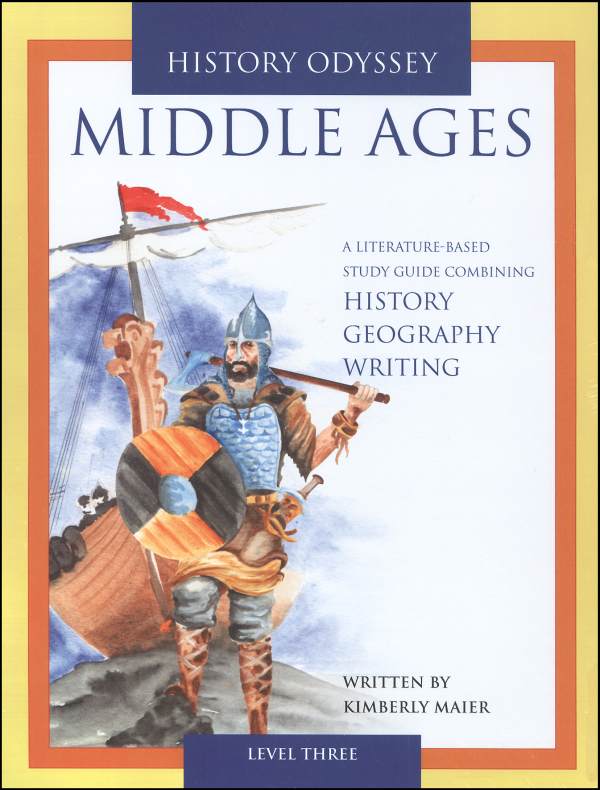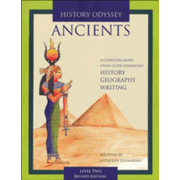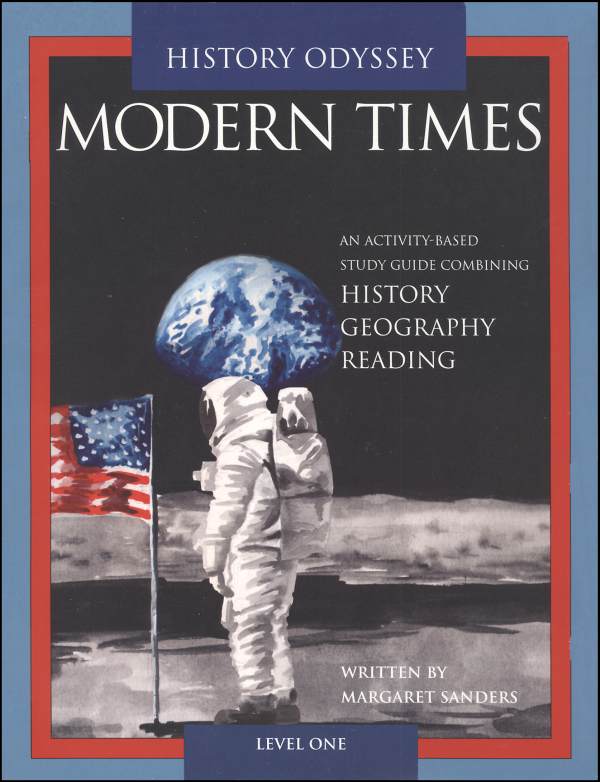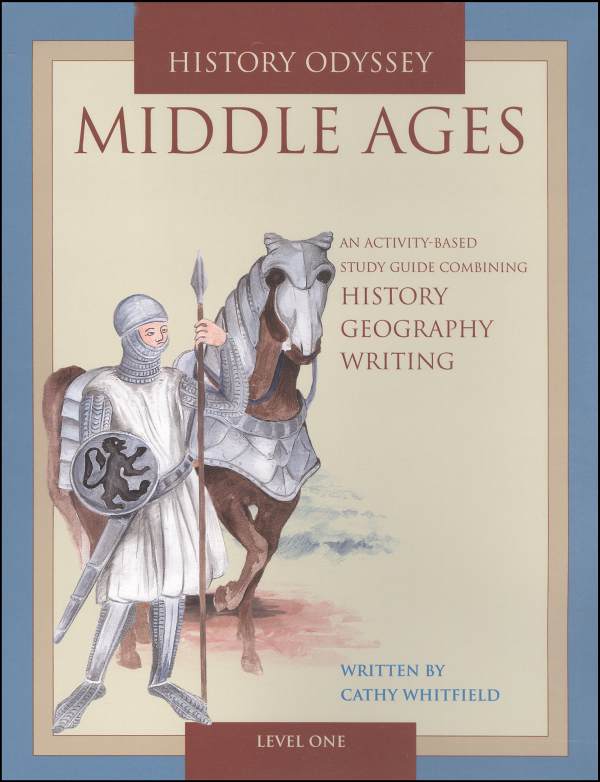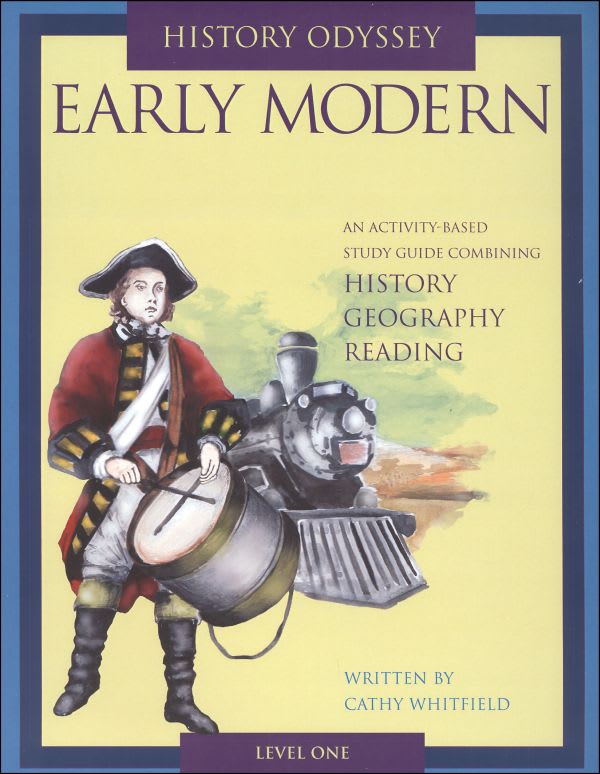History Odyssey combines classical and real-book approaches to create a complete history curriculum for grades 1 through 12. The curriculum has three levels: Level One (Elementary) for grades 1-4, Level Two (Middle School) for grades 5 and up (can actually be used for some high school students but is best for grades 5-8), and Level Three (High School) for grades 9-12. Level One is gradually being replaced by the new History Quest series.
For each level (except Level Three) there are four year-long programs: Ancients, Middle Ages, Early Modern, and Modern Times. Early Times and Modern Times for Level Three are not yet available. The plan is that a student using the entire History Odyssey program cycles through a complete chronological study of history three times. United States history is covered within Early Modern and Modern Times courses at each level, although they also cover world events at the same time.
The level of difficulty and types of activities for each level correspond with a classical education approach that distinguishes grammar, dialectic, and rhetoric levels. In Level One, students learn primarily through stories and hands-on activities such as map work, activities from History Pocket books, coloring, cooking, and arts and crafts projects. For Level One writing assignments, children might dictate to a parent, copy from a book or sample, or write brief summaries of their reading.
Level Two challenges students to begin researching and analyzing, broadening their reading to include primary sources. Learning activities shift toward more critical thinking than at younger levels, although students continue with map work and History Pockets activities. In addition, they construct a timeline, begin to research topics, learn how to outline, and do quite a bit more writing than in Level One.
Levels Two and Three are written directly to the student rather than the parent/teacher, so students might work more independently. Level Three incorporates primary source documents and classical literature into the required reading. Rhetorical level activities here include a great deal of writing such as thesis statements and research papers. However, students continue with map work, a timeline, and some worksheet activities.
Each guide presents a number of lessons—although a single lesson might take a week to complete in Level One and a day to complete in Level Three—volumes do not follow a set pattern in this regard. Lessons are essentially checklists of assignments. Most of the time students will be acquiring information from the required books and resources, although they will sometimes refer to an appendix in the back of the guide, especially at the two upper levels. Students should complete most of the activities, although parents need to exercise their own discretion as to which supplemental books to have children read. Of course, parents might decide to skip some activities, but this is easier for parents to control in the first level than in Levels Two and Three where students might be working independently most of the time.
Level One volumes include formal suggested schedules for the year in chart form, while Levels Two and Three have suggestions in the introduction regarding the length and frequency of lessons. Students in the upper levels are likely to vary so much in the time they spend on the different assignments that it only makes sense for parents to set their own schedules.
There are no answer keys and tests for History Odyssey because they are not appropriate for this style of education. Instead, students create a binder for their work each year—sort of a portfolio approach to demonstrate mastery of subject matter and skills. Nevertheless, parents will need to be somewhat familiar with the material to properly evaluate a student's work. This will likely be most challenging at Level Three because of the large volume of reading required of students. Parents should also be aware that these courses do not provide comprehensive instruction in writing; while some skills such as outlining and essay writing are covered, comprehensive skills must be developed using other resources.
There is a single guide book for each time period of each level—twelve volumes eventually in all. Each guide comes shrink-wrapped and pre-punched for insertion into your own three-ring binder (view binder recommended). A full-color cover page can be inserted onto the front of your binder.
Guides include lesson plans, writing assignments, reproducible blackline maps and worksheets, suggested activities, and resource lists. Core books are required for use with each volume, although some core books are used along with two or more volumes. For example, The Usborne Encyclopedia of World History is used as a core book for all Level One guides, while Story of the World: Volume 2 is among other books used for the Middle Ages guide for this level. The Kingfisher History Encyclopedia and The Story of Mankind (by H.W. Van Loon) are used for all Level Two guides, while The New Penguin History of the World (by J.M. Roberts) and The World's Great Speeches are used with all Level Three guides. Additional fiction and non-fiction books that you might borrow from the library are used along with each level. Pandia Press's History Odyssey Timeline charts or one that you create yourself is also required for levels two and three.
The primary core books used for more than one guide are all secular, and the same is true of most of the recommended reading. The Story of the World: Volume 2 (used with Middle Ages, Level One) was the only title that stands out as having a Protestant point of view. Activities in the guides include perspective throughout is generally secular but with a positive view of Christianity.
Use the same volume with more than one child if they fall within the range of grade levels. If teaching more than one child at different levels, you might choose the same time period even if it is out of sequence. Topics DO vary from level to level in volumes covering the same time period so, for instance, students working in Levels One and Two of the Middle Ages course would not be studying the same things at the same time. However, over the course of the year, there will be significant overlap and students might benefit from some shared read-aloud books.
History, geography, and writing receive primary attention in this program. Although writing instruction might be provided with another resource, students might do the bulk of their writing activities in response to assignments from History Odyssey. Since children are likely to read a large number of books for History Odyssey, they might also receive credit towards reading or literature. Typically, for the Levels Two and Three courses, students earn one credit each in history and language arts, and at least a partial credit in geography.
Level One will require more parent/teacher preparation and presentation time than the other levels. All levels will require procurement of the required books and resources in advance. Parents will need to oversee and evaluate student work for all levels, a responsibility that will take some time since the activities are open-ended rather than tests that are easily graded.
History Odyssey seems to have struck a good balance combining the classical approach with complementary activities appropriate for the different age levels in such a way that parents should be able to manage reasonably as long as they are not working at three different levels simultaneously. In my opinion, this program should actually work best for families that can work within one level at a time. Families that need to span more than one level might look for one or more families with whom they might partner to make it more manageable.










